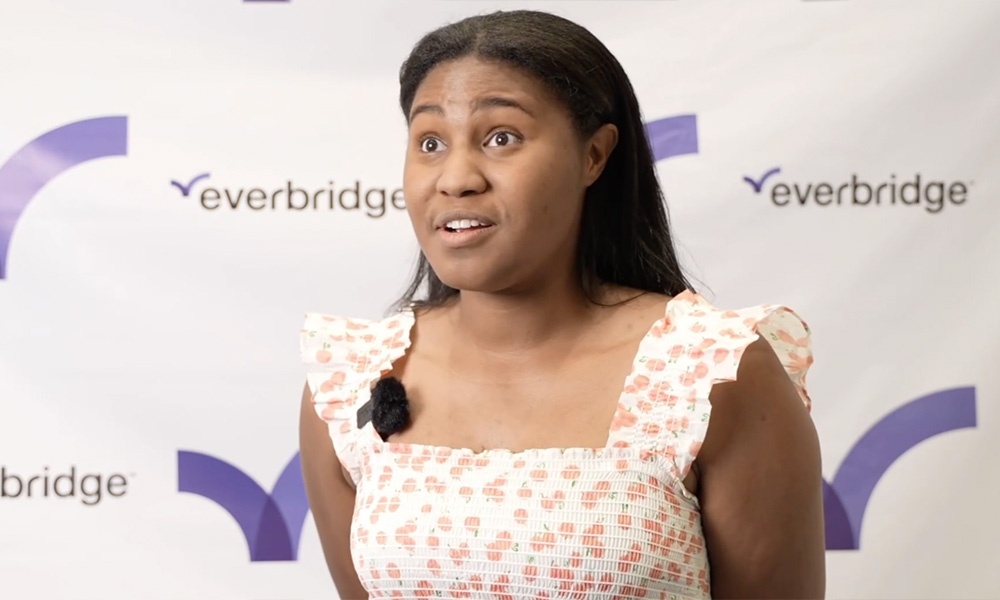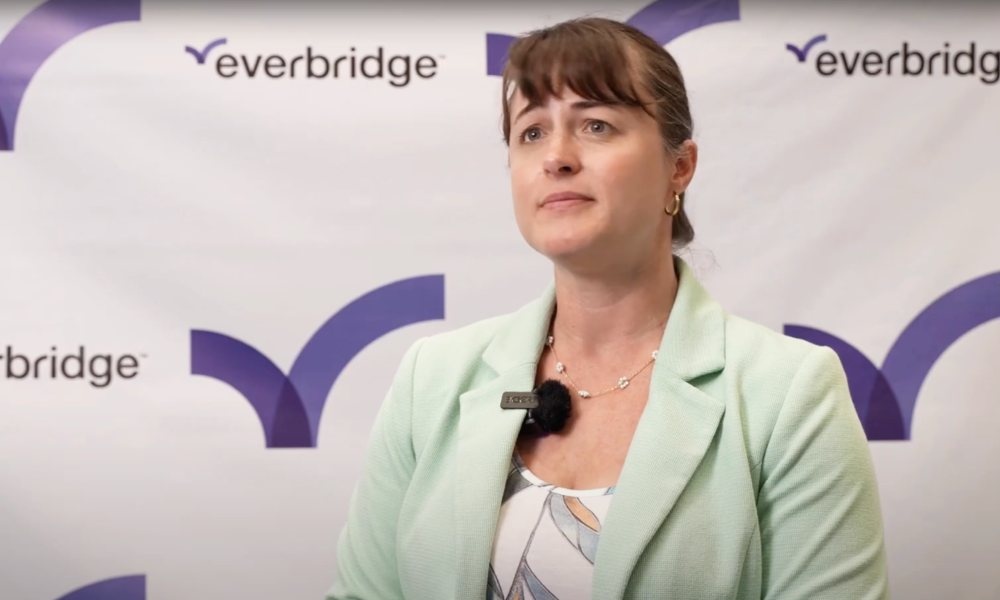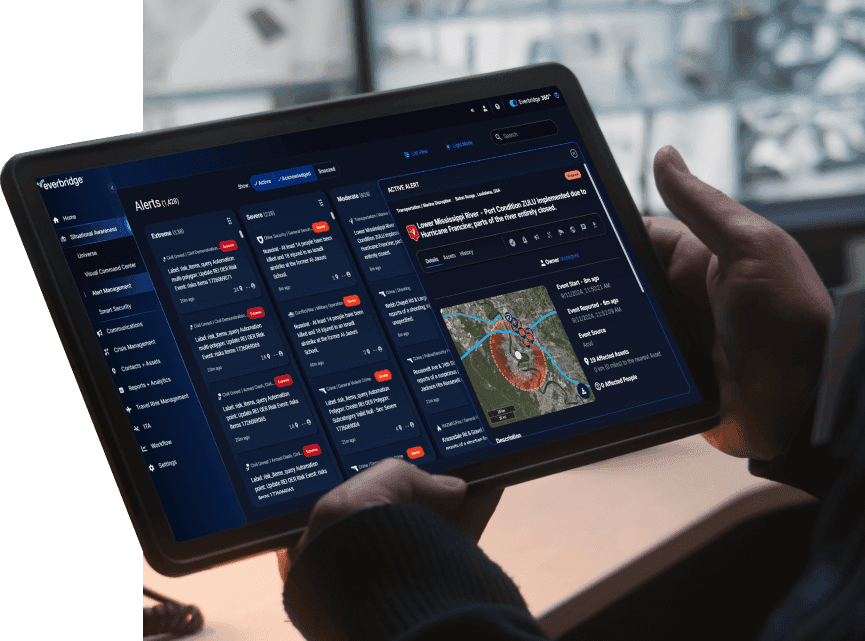Discover how Ameren leverages Everbridge to stay resilient during Midwest weather disruptions and ensure regulatory compliance for nuclear facilities. From location-based notifications with maps to customizable forms for external stakeholders, Everbridge transforms how Ameren handles critical events.
Full video transcript
[00:11.4]
Everbridge has changed the way my team responds to disruptions and critical events in a variety of ways. One way I can think of is, we tend to have bad weather in the Midwest. Inclement weather, whether it’s like, tornado season, whether it’s fire season, or even in the winter.
[00:31.5]
It always kind of poses, challenges operationally and also just for coworkers trying to get to their work center.
[00:44.9]
One thing that happened this winter was that there was a massive, snow and ice storm and business segments were scrambling, trying to figure out who was going to be able to be remote, who was going to be able to work where. And Everbridge really came in key there because there’s a really nice function, with their incidents and notifications that allows you to kind of create an ad hoc HTML, little web page.
[01:08.8]
And that page you can actually add valuable, visual information like maps. So we were able to utilize this function and send texts to key, employees at specific locations, because Everbridge also allows you to put in specific location information for employees.
[01:27.2]
So we were able to target the employees who work at specific places and then send them key information just pertinent to them so they knew, where was safe to drive and where wasn’t, and it also kind of helps other employees know, okay, if we sent you a certain message, you don’t report to work.
[01:44.9]
But if we sent you this message with maps and information, then you know exactly how to get to work and exactly where to park and where the safe spots are.
[01:57.5]
The one way Everbridge has helped my organization stay resilient is just how customizable it is to situations that might happen to differt business segments. One such time is we support, nuclear facilities, and one of the nuclear facilities needed to find a way to send customizable information to external stakeholders that needed to be received in a very specific amount of time and acknowledged in order to maintain, regulatory compliance with their governing body.
[02:32.3]
So through Everbridge we were able to engage some professional services and build out really, really complex forms that had various ways to input information. So they were like dropdown toggles. There was a place for manual input, and it was great because it allowed them to achieve the level of granularity that was necessary.
[02:53.8]
And then send that to external stakeholders who were simply able, type like yes, or whatever they needed, to respond within the allotted time. This was vastly different than the system that they were using before, in the best possible way. We could see that data visualized exactly when people responded, who responded.
[03:13.1]
And we had the flexibility to send it to, specific people within an organization. So it was just incredible. The nuclear team is using it and they’re loving it. And we are constantly in conversations about how we can further expand.
The fire season isn’t just confined to summer anymore. A disturbing phenomenon is emerging from the depths of our forests: zombie fires that smolder underground for months, only to resurrect when conditions align. These holdover fires represent one of the most challenging aspects of modern wildfire management, posing unprecedented risks to communities and ecosystems alike.
Understanding zombie fires isn’t just academic curiosity. For emergency managers, community leaders, and residents in wildfire-prone regions, these persistent blazes demand immediate attention and strategic preparation. The 2023-24 fire seasons in Canada alone recorded over 150 active holdover fires, a staggering 10-fold increase from historical norms, which signals a fundamental shift in fire behavior patterns.
This blog examines what makes zombie fires so dangerous, why they’re becoming more common, and most importantly, how organizations and communities can protect themselves using proven emergency management strategies and advanced technologies.
What is a zombie fire?
Zombie fires, also known as holdover fires, are wildfires that survive winter by smoldering deep underground in organic soil layers, peat deposits, and dense root systems. Unlike surface fires that consume vegetation and move horizontally across landscapes, these fires burn vertically downward, creating underground heat sources that can persist for months without visible flames.
The term “zombie” perfectly captures their resurrection-like behavior. A fire that appears completely extinguished in October can suddenly produce smoke columns the following April. This underground persistence occurs primarily in carbon-rich environments where thick layers of organic matter provide sustained fuel for slow combustion.
Recent examples from North America illustrate the scale of this challenge. The Donnie Creek fire in British Columbia’s Peace Country, spanning 619,000 hectares, continued showing heat signatures through January 2024 despite being declared “under control” in October 2023.
What causes zombie fires?
The formation of holdover fires results from a complex interplay of environmental factors, with peat-rich soils serving as the primary enabler. Peatlands accumulate organic matter over millennia in waterlogged conditions, creating dense carbon deposits that can sustain combustion even under adverse conditions. When these carbon-rich layers dry sufficiently, they become ideal fuel for sustained underground burning.
Climate change significantly amplifies zombie fire conditions. Rising temperatures extend fire seasons while reducing soil moisture content in northern regions. Warmer winters provide insufficient moisture to fully extinguish deep-burning fires, allowing them to persist in sub-surface smoldering states.
Human activities also contribute to the problem through incomplete fire suppression practices. Traditional firefighting methods focus on surface flames and immediate heat sources, often missing deep-seated combustion in organic soil layers. Additionally, activities like campfires, prescribed burns, and industrial operations can ignite organic soil layers that continue burning long after surface fires are declared controlled.
The interaction between these factors creates perfect conditions for zombie fire development. As northern regions experience longer, hotter fire seasons combined with reduced winter precipitation, the likelihood of fires persisting underground increases dramatically.
The risks of zombie fires to the environment and communities
Zombie fires pose multifaceted threats extending far beyond immediate fire damage. Their environmental impact centers on massive carbon releases that significantly contribute to global climate change. Canada’s 2023 fire season accounted for 23% of global fire emissions for 2023. Holdover fires extend these emission periods into subsequent years, creating ongoing atmospheric pollution that compounds climate change impacts.
Community risks from holdover fires include unexpected re-ignitions near residential areas, prolonged smoke exposure, and significant economic impacts. The unpredictable nature of zombie fire re-emergence makes evacuation planning extremely challenging, as communities may face fire threats during traditionally “safe” periods. Infrastructure damage from these persistent fires creates substantial economic losses, while extended smoke exposure contributes to respiratory health problems across broad geographic regions.
The 2024-25 fire seasons demonstrated these risks through multiple community evacuations, including 27,000 people displaced in Canada and widespread air quality advisories affecting millions across North America. Nearly 30% of the forested land in British Columbia’s Prince George Fire Centre is expected to burn by the end of 2025, driven by long-term drought and climate change. These incidents highlight the urgent need for enhanced emergency preparedness strategies, detection systems, and critical event management solutions.
Management and prevention of zombie fires
Effective zombie fire management requires comprehensive strategies that address detection, suppression, and community preparedness. Traditional firefighting approaches must evolve to account for the unique characteristics of holdover fires, while communities need specialized preparation for extended fire risk periods. Increasing investments in year-round firefighting capabilities and mitigation strategies are vital for many regions around the world.
Fire management agencies are developing specialized approaches for zombie fire detection and suppression. Winter infrared surveillance programs now operate across Canada and Alaska, using helicopter-mounted thermal imaging systems to identify heat sources in previously burned areas. These patrols occur every 10-14 days during winter months, providing early warning of potential spring re-ignitions.
Innovation in zombie fire detection continues to advance through multiple technological approaches. Space-based monitoring systems are developing enhanced capabilities specifically targeting low-temperature, sub-surface fires. The upcoming FireSat constellation, launching in 2026, will provide 5×5 meter hotspot detection with 9-20 minute revisit intervals—the first satellite system specifically designed for sub-canopy and subsurface fire detection.
Emergency communication systems continue to evolve to manage the unpredictable nature of zombie fire re-emergence effectively. Communities require robust alerting systems capable of rapidly notifying residents during unexpected fire activations, particularly during spring months when holdover fires commonly resurface.
Everbridge supported communities during air quality emergencies caused by the 2023 Canadian wildfires through timely mass notification alerts and safety instructions. Local governments were able to communicate with vulnerable populations, such as young children, the elderly, and those with respiratory conditions, ensuring they take necessary precautions.
Building resilience against hidden fire threats
Zombie fires represent a fundamental shift in wildfire behavior that demands equally fundamental changes in how communities and organizations approach fire preparedness. These persistent underground threats blur traditional seasonal boundaries and create year-round risks requiring sustained vigilance and advanced preparation strategies.
The evidence from recent North American fire seasons demonstrates that holdover fires are no longer rare occurrences. From British Columbia’s 150 active holdovers to Alaska’s persistent sleeper fires, the scale of this challenge requires immediate action from emergency managers, community leaders, and residents alike.
Understanding zombie fire behavior, implementing comprehensive detection and monitoring systems, and maintaining robust emergency response capabilities provide the foundation for community resilience. Threat assessment and preparedness must operate on a continuous basis.
Take action today by downloading Everbridge’s Wildfire Preparedness Checklist for Businesses to ensure your organization is ready to manage both conventional and zombie fire threats.
Full video transcript
[00:11]
Biggest benefit for Everbridge is keeping everybody together, keeping everybody in communication. We primarily use it for our BCP notification system. And so keeping everybody together and quick notification, quick responses. We actually used it during COVID for, asking people.
[00:27]
You had to every day ask somebody if they were well enough to come into work. And it was amazing. Without that system, we wouldn’t be in compliance with all of the COVID guidelines. So we love it.
[00:42]
Some advice I would give to anybody that hasn’t, you know, decided to switch to Everbridge is do it. There is no bad reason. There’s no, there’s only benefits. Let’s just say that there’s. It’s a great, it’s a great company, it’s a great program.
[00:58]
The service is wonderful. And I mean, we wouldn’t be where we are today without it.
[01:07]
The way we respond to critical events now because of Everbridge is, it’s more organized. There’s a BCP plan. We’re able to communicate, obviously better together. We’re able to get responses faster. The notifications, it’s great on my mobile phone, so if I’m in route, I can quickly grab the app and send out notifications.
[01:27]
But it’s just the response times are just so much faster than anything we had before. Before people come in, the branches, you know, everybody’s got different hours of when they come in. But if we can get a notification out to everybody ahead of time, they know what to expect when they come in, which is, as you know, communication is key in everything.
[01:44]
So even if it’s before they come into work, they know that they’re coming into something instead of having it be a shock and surprise when they get there.
[01:55]
Resilient. I think that without them, there’s a lot of functions that we couldn’t do today, especially in a BCP scenario. We depend on them a lot. When Zoom was down We had no other way to communicate. It’s our whole system and we had no other way to communicate with everybody except through the Everbridge conference line.
[02:14]
And I it was an amazing thing. I it was quick to get up, sent it out to everyone and said, let’s figure out what we’re going to do with all of our communications down.


